At Brighton on Sunday, Jonas Eidevall started Alessia Russo and Stina Blackstenius together for the second time. Pre-game, Arseblog News likes to filter WSL data and see which areas Arsenal’s opponents show up very strongly in. Brighton lead the WSL in one category available on FBRef. Passes in their own penalty area.
Arseblog News asked Eidevall whether Brighton’s commitment to playing out from the back informed his decision to start Russo in a withdrawn role behind Blackstenius. “When you play Brighton either they are in that mode when they are playing out from the back. We saw with their goal against Manchester City they can push out their defending line and they have some really strong target players too, with Lee, Pauline Bremer and Terland too so they play up there and flick on so you have to handle that situation.
“It was about handling both situations, especially with our counterpressing too, we wanted to be really aggressive and get that suffocating shape so we could sustain attacks and we did that really well in the second half.” Let’s look at some examples.

The first time Brighton play out from Sophie Baggaley, look at Arsenal’s intent to press. Eidevall also explained that he wanted to start Blackstenius because her ability to run in behind was a key part of pushing Brighton back. “It was important to stretch their back line and having a threat in behind, but also to have someone who is really good at capitalising on that space in front and that created a dilemma for Brighton.”

But Eidevall also wanted Russo’s pressing qualities. Losada plays a slightly loose pass in midfield here and Russo is like a coiled spring.

Russo intercepts and passes the ball back to Cooney-Cross. Crucially, Blackstenius is still loitering on the shoulder of the last defender, which keeps Bergsvand and Thorisdottir pushed back. It means that Brighton cannot get numbers in support in the middle of the pitch.

Here we see Russo in that withdrawn position pressing and disrupting Brighton in possession again. This is both to stop Brighton from hitting their front three and to get Arsenal on the attack. Blackstenius is hovering at the tip of the defensive line again, meaning that Russo can press without Arsenal losing any threat in behind and without Brighton being able to raise their defensive line to step onto Arsenal.

The loose ball breaks to Pelova, who switches the ball to McCabe on the left. Arsenal have forced a turnover here.

McCabe finds this run in behind from Blackstenius but the Swede’s shot is deflected behind for a corner. Arsenal’s aim was to use Russo’s excellent pressing in slightly deeper areas but retain threat in behind with Blackstenius’ running.

Eidevall also talked about a focus on counterpressing, which he felt the pairing of Russo and Blackstenius was well placed to do. Blackstenius gives Arsenal the option of being more direct, as we see here as Wubben-Moy wins the ball in the area and finds Foord.

A strong counter pressing strategy doesn’t require painstaking accuracy in long passing, it’s about playing in areas where opponents feel uncomfortable. Foord’s pass is not straight onto Stina’s laces but it is in an area where she can challenge for it and emerge with the ball while the defence is not set.
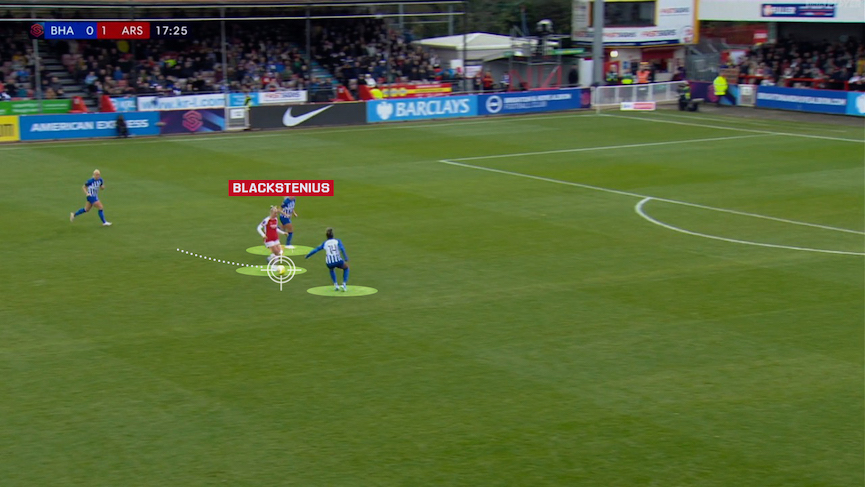
Through counterpressure, she has the ball in a very dangerous situation here.
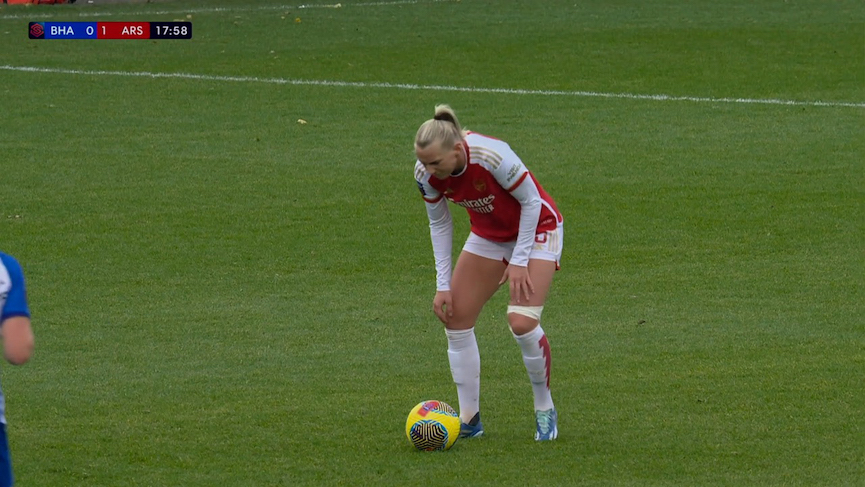
However, she collides kneecap for kneecap with a Brighton defender and the pain stops her flow.

As Brighton try to play out here, look again at the intensity of the Arsenal press on Carabali.
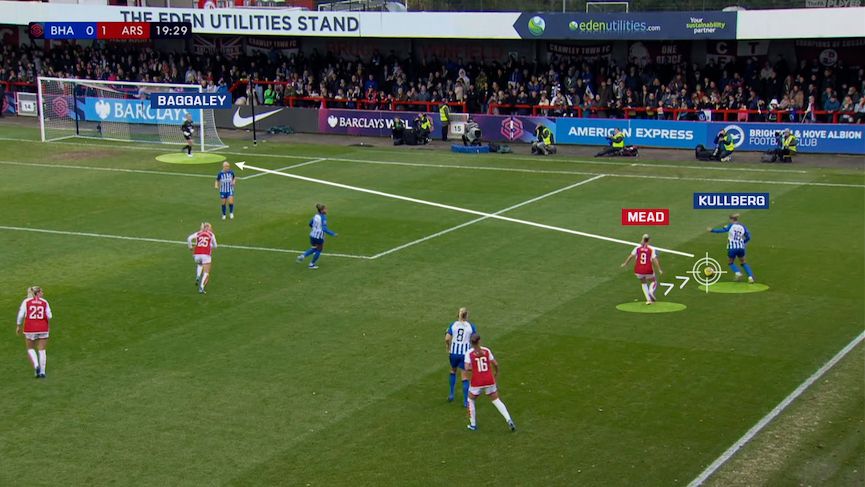
The ball is tucked back to Kullberg via Bremer but Mead presses her and won’t let Kullberg turn her body shape forward. Brighton often like to switch play in these positions and Mead’s pressing is as much about stopping that as it is winning the ball back.

Kullberg is forced back to Sophie Baggaley and because Arsenal have Blackstenius positioned nice and high up, she can immediately close Baggaley down.
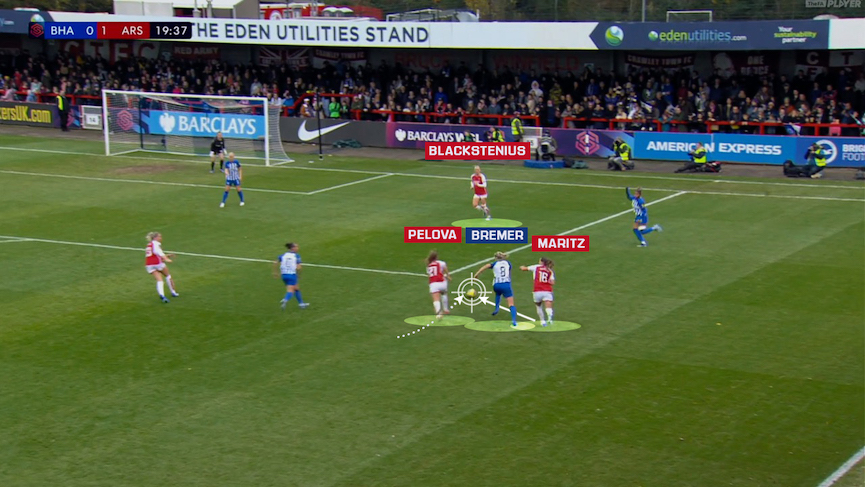
Baggaley finds Carabali but her pass up the line to Bremer is intercepted by Maritz and Pelova is onto the loose ball in the Brighton area and, again, because of the height of Blackstenius’ position, she is in a threatening space when Arsenal do force a turnover. Pelova feeds the Swede, whose shot is blocked. It’s another good example of pressing and then having Stina close to the opponent’s goal to latch onto any turnovers. This press also prevents Brighton from the big switches of play they like.
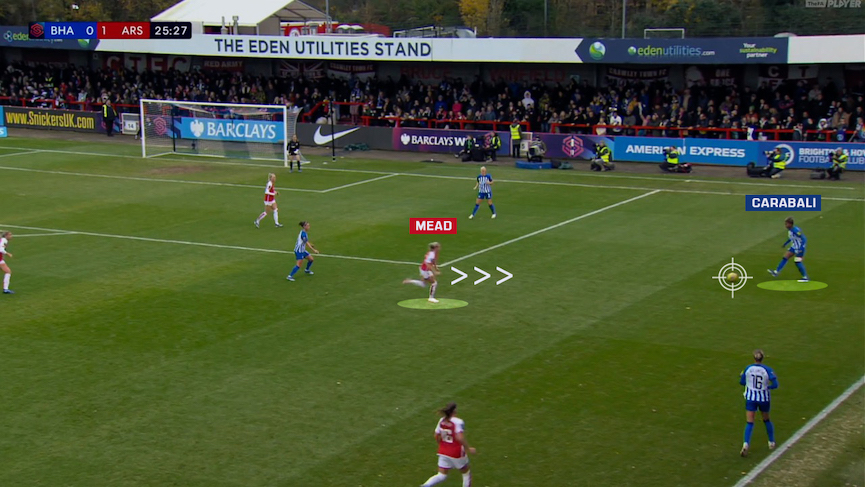
Pressing Brighton was as much about preventing them from attacking as it was Arsenal trying to force turnovers. Brighton play out here and get the ball back to Carabali again. Brighton like to play out from the goalkeeper, invite the press and then use Carabali to play over the top of the press, or switch the play and that is what they have prepared here, but look at Mead as the ball is worked back to Carabali.
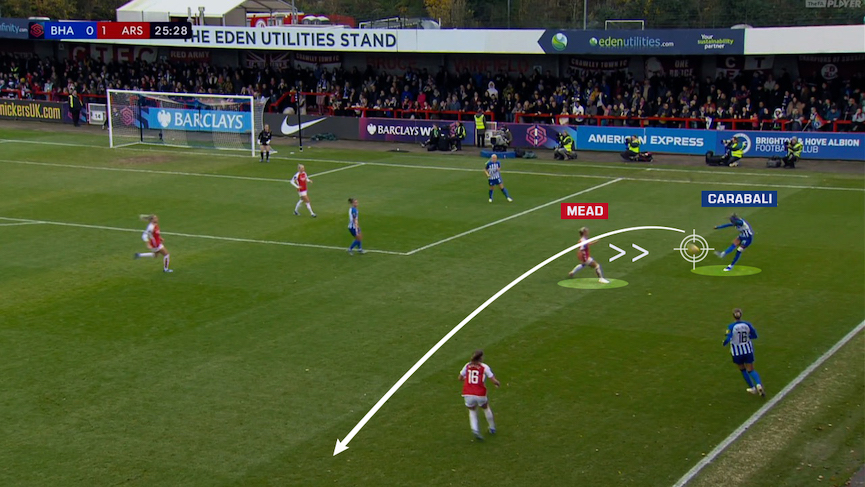
Mead presses at an angle that cuts off the crossfield pass. As a result, Carabali instead tries to play a much harder pass to Bremer on the same flank.

And Bremer can only flick it out of play.

However, Arsenal’s press sagged in last 15 minutes of the first half and Eidevall said post-match that he spoke with his players about this at half-time. Here Carabali is under very little pressure in possession.
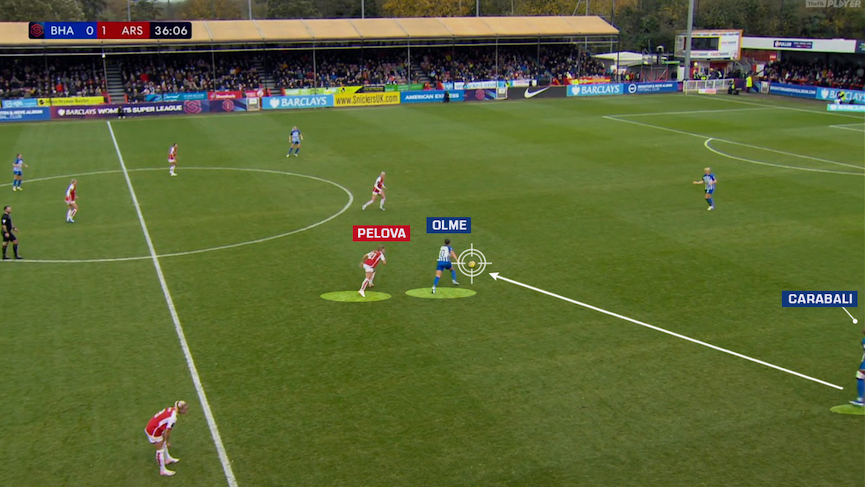
She has an easy pass in-field to Olme and Pelova doesn’t get tight enough to stop Olme from turning.
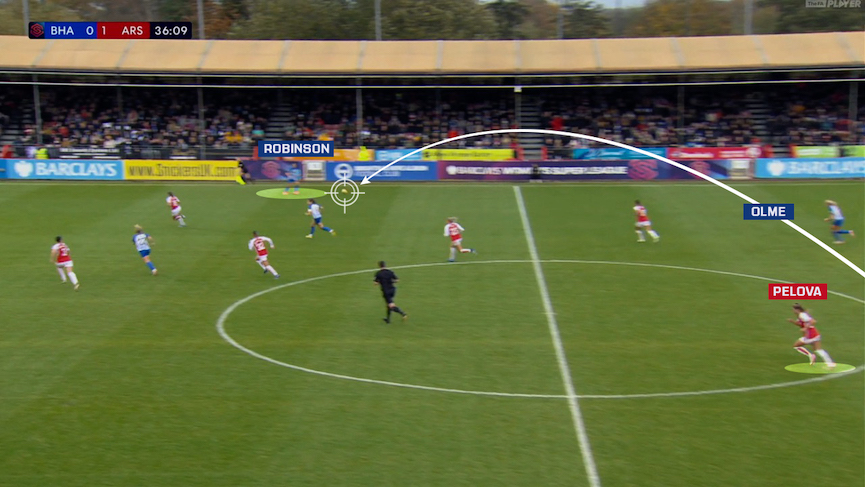
And Olme is able to whip the ball out wide to Katie Robinson. These are the switches of play Brighton really like to stretch teams. ‘We gave them way too much time and space in the first half,’ Eidevall told us post-match. ‘They are expansive in their organisation and they like to switch from side to side and stretch your organisation, especially if you are not close enough to impact the quality on their pass.’
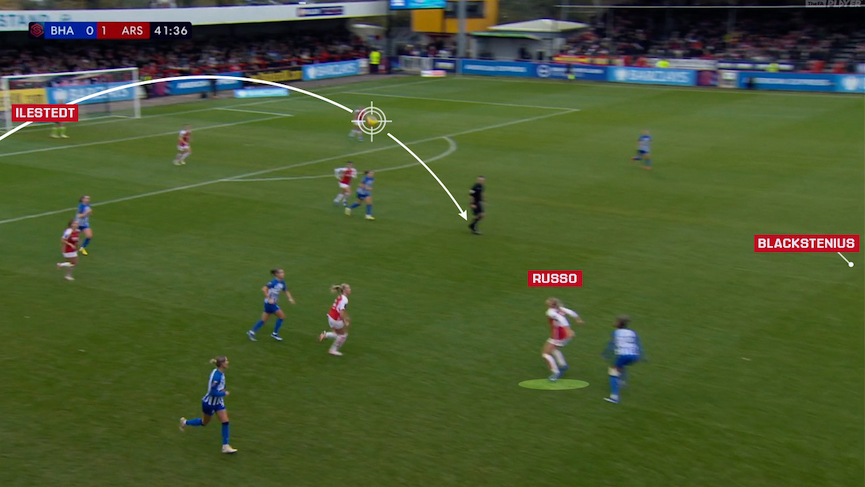
Here we see a more obvious example of Russo and Blackstenius partnering. Ilestedt clears her lines and Russo has moved deep to compete for the header. If Russo is playing as the sole striker here, she would need to try to control the ball, hold off a marker and wait for support to arrive.

But with Blackstenius in behind, it means Arsenal have someone ahead of Russo and she comes to meet the ball and spins a pass out to Foord here. Foord is nearly one-on-one with Bergsvand from this pass but Bergsvand does really well to stop Foord from getting a run at her.
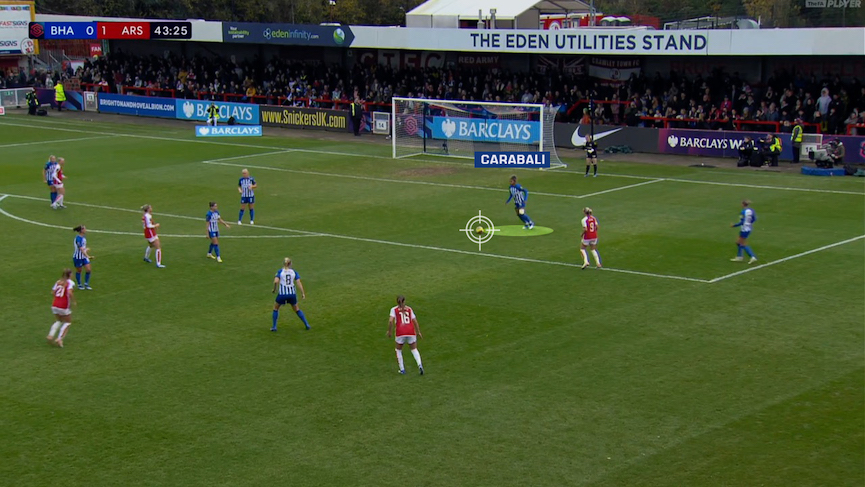
We see a lack of intensity in the Arsenal press here again as Carabali collects the ball in her area. The timestamps show you how long she is afforded to pick her pass.
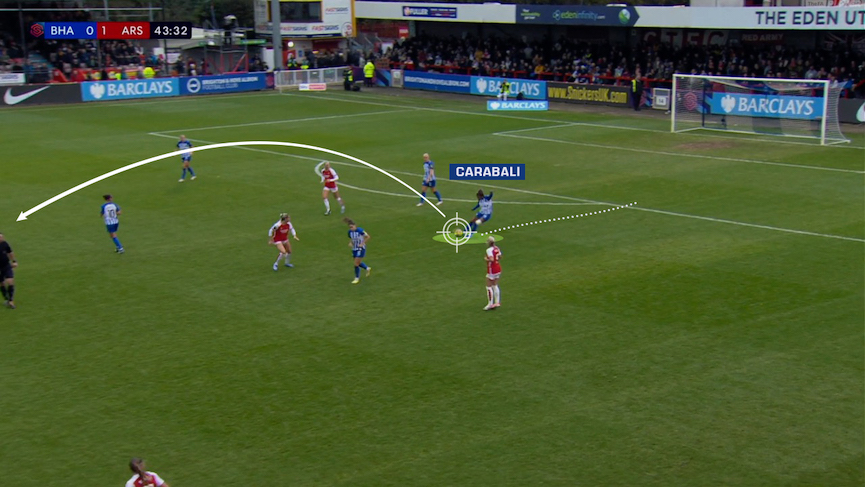
Seven seconds and around 10 yards later, Carabali picks her pass.
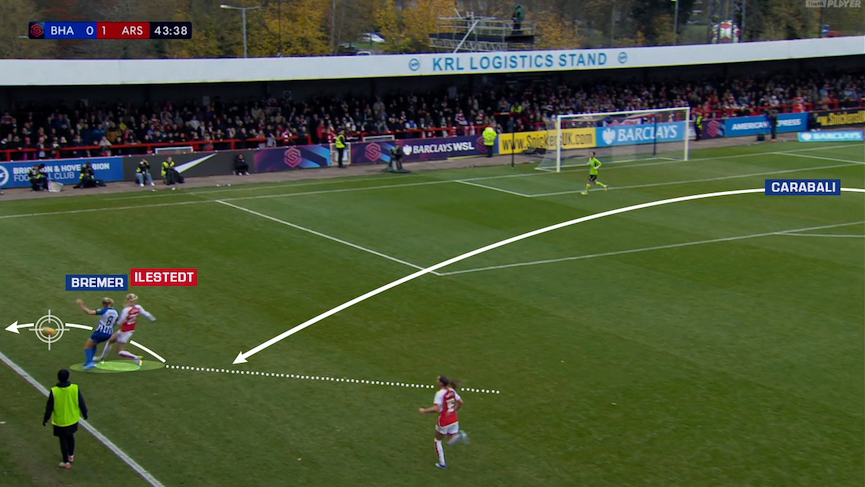
Ilestedt has to come across and concede a throw deep in Arsenal’s half. Compare this to the earlier screencaps when Calabali has little time and space to hit Bremer and can only concede a throw-in on the halfway line.

From the subsequent throw-in, Carabali is again afforded lots of time and space.

And she arrows a dangerous pass to Robinson. In the second half, Arsenal tidied this aspect of their play up again and got tighter to Brighton players. Calabali moved into midfield in the second half to try to contend with the spaces Russo was picking up.
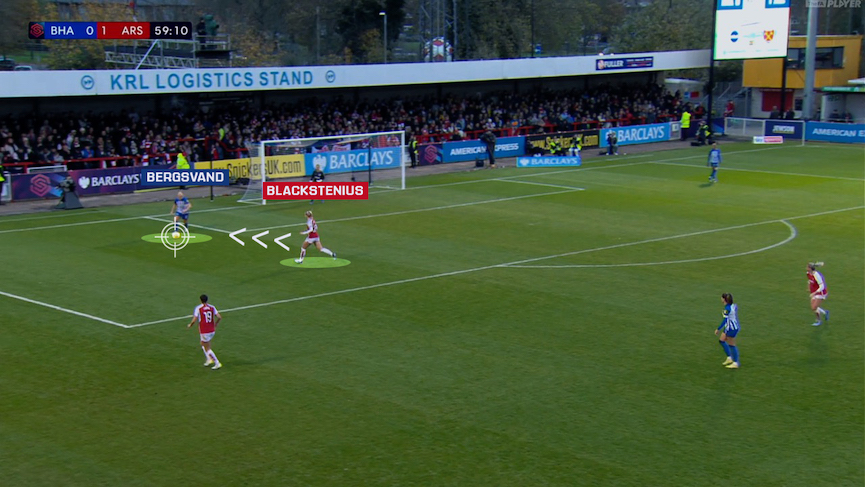
Here’s a good second half example of Blackstenius’ aggressive positioning aiding Arsenal’s game. She presses Bergsvand here from the Brighton goal kick.

Bergsvand is forced to hurry her pass and McCabe is primed.
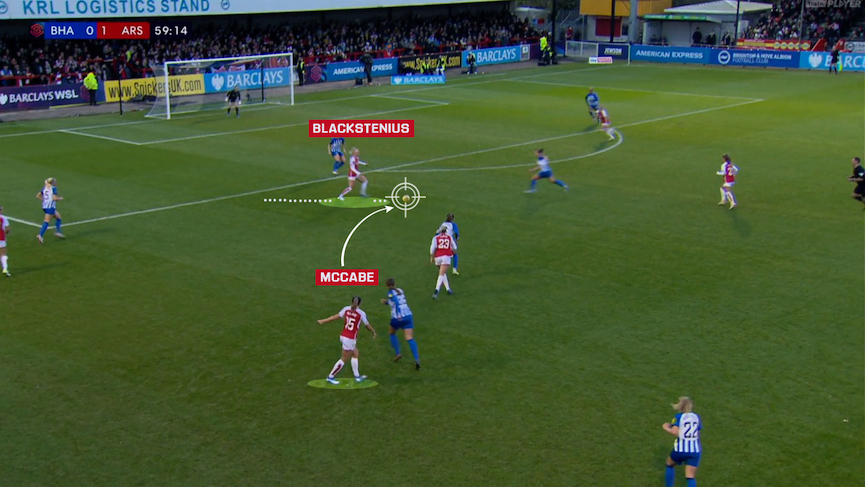
McCabe wins the header and Blackstenius can receive it in a dangerous position on the edge of the area. This is what Eidevall meant about giving Brighton a dilemma, because Stina stayed so high, Brighton had to drop back to look after her.
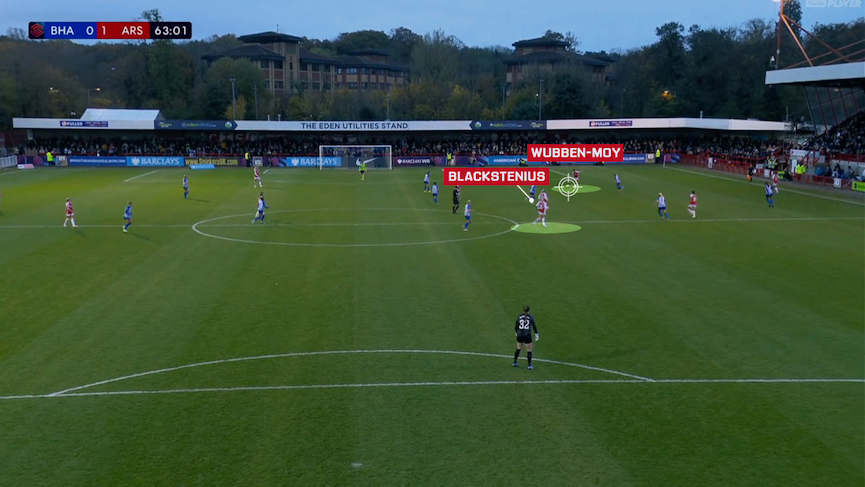
Blackstenius’ last act before she is replaced by Frida Maanum is to give Lotte Wubben-Moy an outlet here as Brighton try to raise their defensive line.
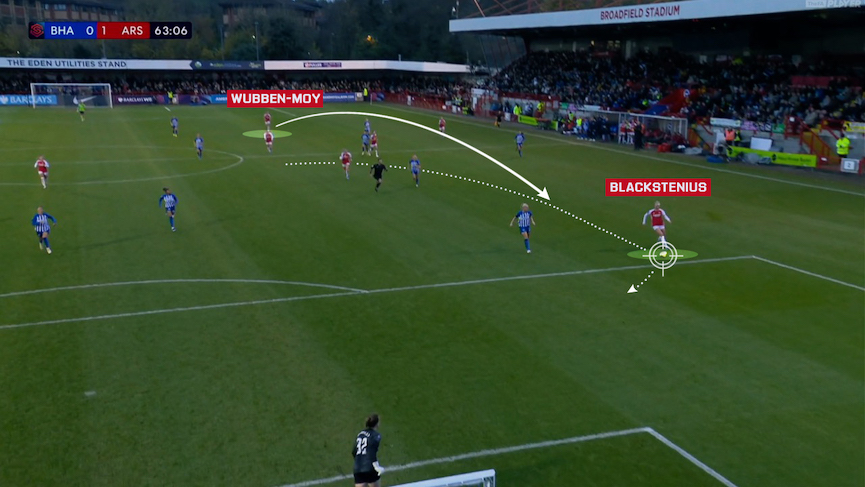
Blackstenius runs onto it and has the ball in a good position. Again, this is the dilemma she gives any team that wants to bring their defensive line forward.
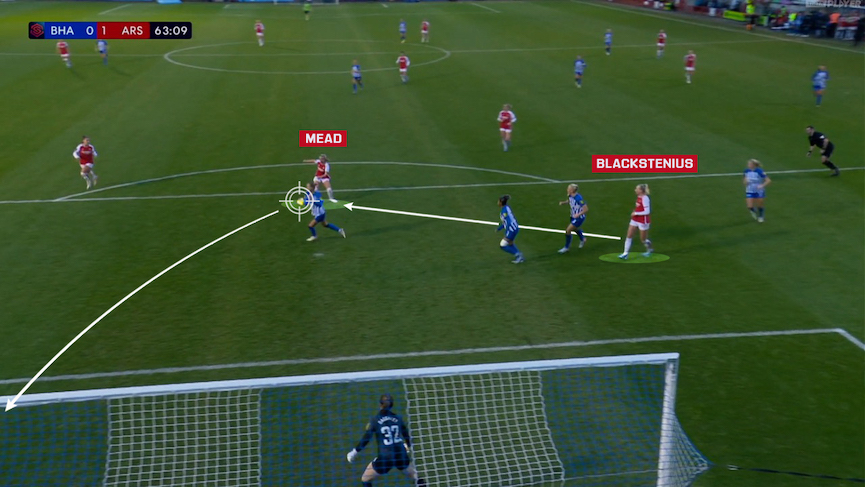
She tees up Mead who shoots narrowly over. At this point, Blackstenius is replaced by Maanum and Russo moves upfront.
The utilisation of both Arsenal’s 9s was about a few things. It was about pressing Brighton, both so that Arsenal could force turnovers but also so that Arsenal could stop Brighton from hitting their forward players early or switching play in the manner that they like.
Arsenal also used Blackstenius’ aggressive positioning and running in behind to pin Brighton’s defence back towards their own goal and stop them from stepping onto Arsenal. It worked well on the day. Arsenal’s striker situation is not as cut and dried as Russo = first choice and Blackstenius = second choice, there are games where Eidevall will want Blackstenius’ high positioning from the start and this was one of them.





This is my first time on this site. Love watching Alessia, Beth, Vivianne and Leah – great players! May I suggest another name for your blog, the word before the word blog seems rather inappropriate, disrespectful, not smart to Arsenal FC and out of order in the women’s game. Surely we need to have higher standards and set better examples to the men’s game,
especially also because we have so many young fans!
Get the fans involved in a competition to find a new name.
It’s been the name of the site for nearly 22 years and it’s incredibly well established so I don’t really think a name change is on the cards (though that isn’t my call, admittedly). I don’t see how it is any more an issue for the women’s team than the men’s. Like, I don’t see Arsenal refusing to call the team Arsenal Women because of the word ‘arse’ in there, which is a gender neutral term / body part in any case! It’s a fan site that often takes a sideways / fans view of things so the name fits.
Modern mentality, I give up! So we are meant to change the name of our club now in case it might offend someone? The word ‘Arsenal’ probably arrived in England around the 1500’s and it is a French word derived from Latin ‘Arsenale’ which in itself is a bastardisation of an Arabic word meaning “house of manufacture”. Nothing to do with anybody’s bottoms, male or female! Of course, we took the name from The Royal Woolwich Arsenal (which is why to me this club will always be a South London club on loan to Islington!) which is where armaments and… Read more »
…. What a brilliant lay off by Lacasse !!!
Lovely analysis as always Tim. Thanks – enjoy them a lot after each game!